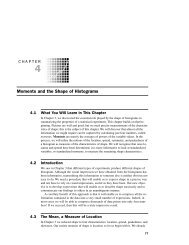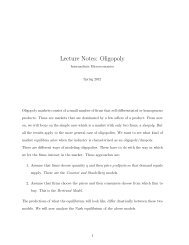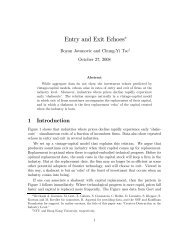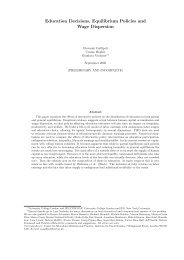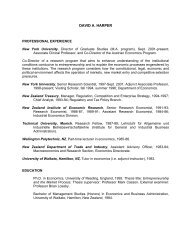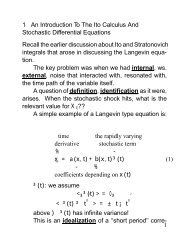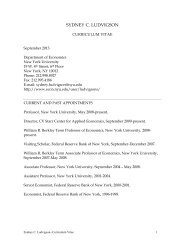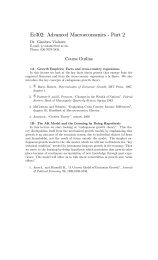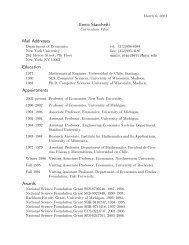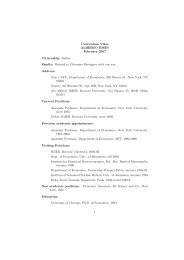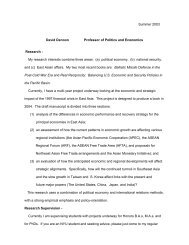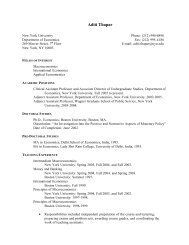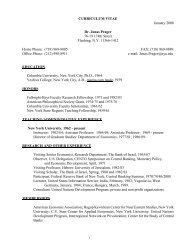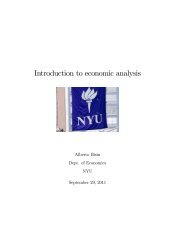On Spatial Processes and Asymptotic Inference under Near$Epoch ...
On Spatial Processes and Asymptotic Inference under Near$Epoch ...
On Spatial Processes and Asymptotic Inference under Near$Epoch ...
Create successful ePaper yourself
Turn your PDF publications into a flip-book with our unique Google optimized e-Paper software.
with cin = 1. (Note that Assumption 3(d) is satis…ed automatically since the<br />
qi;n(Zi;n; o n) are uniformly L2-NED.) Hence,<br />
1=2<br />
n jDnj Rn( o X<br />
1=2<br />
n) = n qi;n(Zi;n; o n) =) N(0; Ipq ); (C.11)<br />
with n = V ar P<br />
i2Dn<br />
i2Dn qi;n(Zi;n; o n) <strong>and</strong> sup n max<br />
h<br />
jDnj 1 i<br />
n < 1.<br />
Step 3. By Assumptions 7(c),(d),(e) the functions r qi;n(Zi;n; ) satisfy for<br />
each 2 the LLN given as Theorem 2 in the text with ci;n = 1, observing<br />
that Assumption 4(b) is implied by 2. By argumentation analogous as used in<br />
the proof of consistency we have<br />
jDnj<br />
1 X<br />
i2Dn<br />
(r qi;n(Zi;n; ) Er qi;n(Zi;n; )) p ! 0:<br />
By Proposition 1 of Jenish <strong>and</strong> Prucha (2009), Assumption 7(f) implies that the<br />
r qi;n(Zi;n; ) are uniformly L0-equicontinuous on . Given L0-equicontinuity<br />
<strong>and</strong> Assumption 7(e), we have by the ULLN of Jenish <strong>and</strong> Prucha (2009), Theorem<br />
2,<br />
sup jr Rn( )<br />
2<br />
Er Rn( )j p ! 0: (C.12)<br />
<strong>and</strong> furthermore, the Er Rn( ) are uniformly equicontinuous on<br />
that<br />
in the sense<br />
sup jEr Rn( ) Er Rn( )j ! 0 (C.13)<br />
lim sup sup<br />
n!1 02 j<br />
as ! 0. In light of (C.12) <strong>and</strong> (C.13), <strong>and</strong> given that b n<br />
hence e o<br />
n n = op(1), if follows further that<br />
0 j<<br />
o<br />
n = op(1) <strong>and</strong><br />
r Rn( b n) Er Rn( o n) p ! 0; <strong>and</strong> r Rn( e n) Er Rn( o n) p ! 0:<br />
Hence,<br />
bAn An<br />
where b An <strong>and</strong> b Bn are as de…ned above, <strong>and</strong><br />
p<br />
p<br />
! 0 <strong>and</strong> Bn<br />
b Bn ! 0; (C.14)<br />
An = [Er Rn( o n)] 0 P [Er Rn( o n)] <strong>and</strong> Bn = [Er Rn( o n)] 0 P<br />
h<br />
jDnj 1 i1=2 n :<br />
Step 4. Given Assumptions 7(e),(f), <strong>and</strong> since P is positive de…nite, we<br />
have jAnj = O(1) <strong>and</strong> A 1<br />
n = O(1), respectively. Hence by, e.g., Lemma<br />
F1 in Pötscher <strong>and</strong> Prucha (1997) we have b An = Op(1), b A + n = Op(1), b An is<br />
nonsingular with probability tending to one, <strong>and</strong> b A + n A 1 p<br />
n ! 0. In light of the<br />
above it follows from (C.10) that<br />
jDnj 1=2 b<br />
n<br />
o<br />
n =<br />
h<br />
A b+ b 1=2<br />
n Bn n jDnj Rn( o =<br />
i<br />
n) + op(1)<br />
A 1<br />
h<br />
1=2<br />
n Bn n jDnj Rn( o i<br />
n) + op(1)<br />
34



